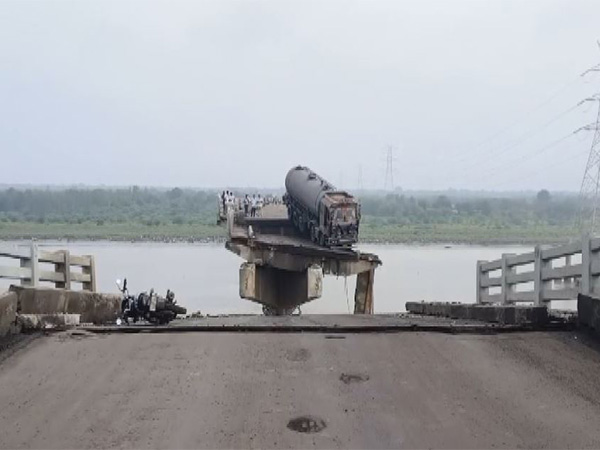A bridge collapsed between Vadodara and Anand, killing 9. Locals blame years of negligence. Here’s why this tragedy was avoidable.
A Morning That Turned Into Mourning

It was just another ordinary morning on the Padra–Anand highway in Gujarat. People were commuting to work, school, and business like any other day. But what happened next shattered lives forever. At around 7:30 AM, the Gambhira bridge — a 40-year-old structure — suddenly gave way and collapsed, sending four vehicles plunging into the Mahisagar river below. Within seconds, the routine of daily life turned into a scene of chaos, fear, and irreversible loss.
Nine people died in the accident. Four others were seriously injured. Among them were fathers, brothers, sons — people who had no idea that the road they trusted every day would betray them so fatally.
A bridge collapsed between Vadodara and Anand, killing 9. Locals blame years of negligence. Here’s why this tragedy was avoidable.
A Bridge That Was Crying for Help
This wasn’t some newly built bridge that collapsed unexpectedly. The Gambhira bridge was constructed back in the mid-1980s. For decades, it served as a crucial link between Vadodara and Anand, a region heavily trafficked by industrial vehicles, private buses, and personal cars. Over the years, the cracks became visible — literally and metaphorically.
Locals had complained several times. The bridge had deep potholes, sagging railings, and visible structural stress, especially after monsoon seasons. Minor patchwork had been done. But there was no major audit, no weight testing, and no structural reinforcement done in recent years. Basically, the bridge was dying a slow death — and no one cared enough to save it.
My Take: This Was No Accident. This Was Murder by Neglect.
And let me be blunt here: this was not just a structural failure — this was a planned tragedy. When a public authority knows a bridge is weakening but still allows it to operate under daily pressure, they’re playing with human lives.
If a private company or shopkeeper neglects safety rules and someone dies, they are arrested immediately. Why don’t we do the same when government departments fail in their duties? Why do officers responsible for infrastructure get away with just “inquiry orders” and transfer letters?
This isn’t just poor governance. This is systemic apathy. When ordinary people die, they become statistics. If a minister’s car had fallen in that river today, half the secretariat would’ve been suspended by now.
Questions That Demand Answers
It’s time we stop waiting for “official probes” and start asking questions that matter:
Why was this bridge not audited every monsoon?
What structural report was filed after the last rainfall?
Which contractor was paid to maintain this bridge — and what did they actually do?
Who signed the fitness certificate for this structure to remain operational in 2025?
These aren’t political questions — they are questions of public safety. And until someone answers them with full transparency, no one should call this an accident.
The Human Cost We Can’t Measure
Nine lives were lost. But behind every number is a shattered family.
One of the victims was reportedly a young truck driver who had just finished a night shift delivering goods. Another was a father of two going to drop his daughter at school. One woman who survived said, “The road just disappeared under our tires.” The trauma these survivors will live with is beyond anything a news bulletin can report.
What’s worse? Most families won’t even get proper compensation. If they do, it’ll be after months of red tape, apologies, and broken promises.
Why Does This Keep Happening in India?
Let’s be honest — we’ve seen this story before. Bridges collapse in Bihar, Maharashtra, Gujarat, and Delhi. Sometimes it’s railway bridges, sometimes it’s flyovers, and sometimes pedestrian overpasses. What’s the common factor?
Old structures not being upgraded
Corrupt or incompetent contractors
No accountability when public works fail
And above all — public apathy after the media cycle ends
It’s always the poor, the working class, and the unnoticed who die first. And they’re also the ones whose deaths are forgotten the fastest.
What Should Happen Now (But Probably Won’t)
After a tragedy like this, there is always a script:
1. Officials visit the site.
2. CM announces a ₹4–5 lakh compensation.
3. A “high-level inquiry” is promised.
4. One or two low-level engineers are suspended.
5. The news cycle moves on.
But here’s what should happen instead:
An immediate FIR filed for criminal negligence against the department responsible.
Public release of past bridge inspection reports.
Third-party audit of all bridges older than 30 years across Gujarat.
Compensation of ₹25 lakh minimum to each victim’s family.
A citizen watchdog portal where infrastructure complaints can be tracked.
Unless this cycle is broken, more bridges will fall — and more lives will be casually written off.
Final Thoughts: Don’t Call It a Tragedy — Call It a Failure
Bridges are symbols of connection, of development. When they fall, it’s not just concrete that breaks — it’s trust.
What happened between Vadodara and Anand isn’t something that should just make the 9 PM news. It should be a turning point. But it won’t be, unless we demand more. Demand clarity. Demand punishment. Demand justice.
The families of those nine people deserve more than flowers. They deserve answers. And the people of Gujarat — and India — deserve a government that respects infrastructure as a matter of life and death, not just politics and contracts.
Until then, every bridge we cross is a silent gamble.
